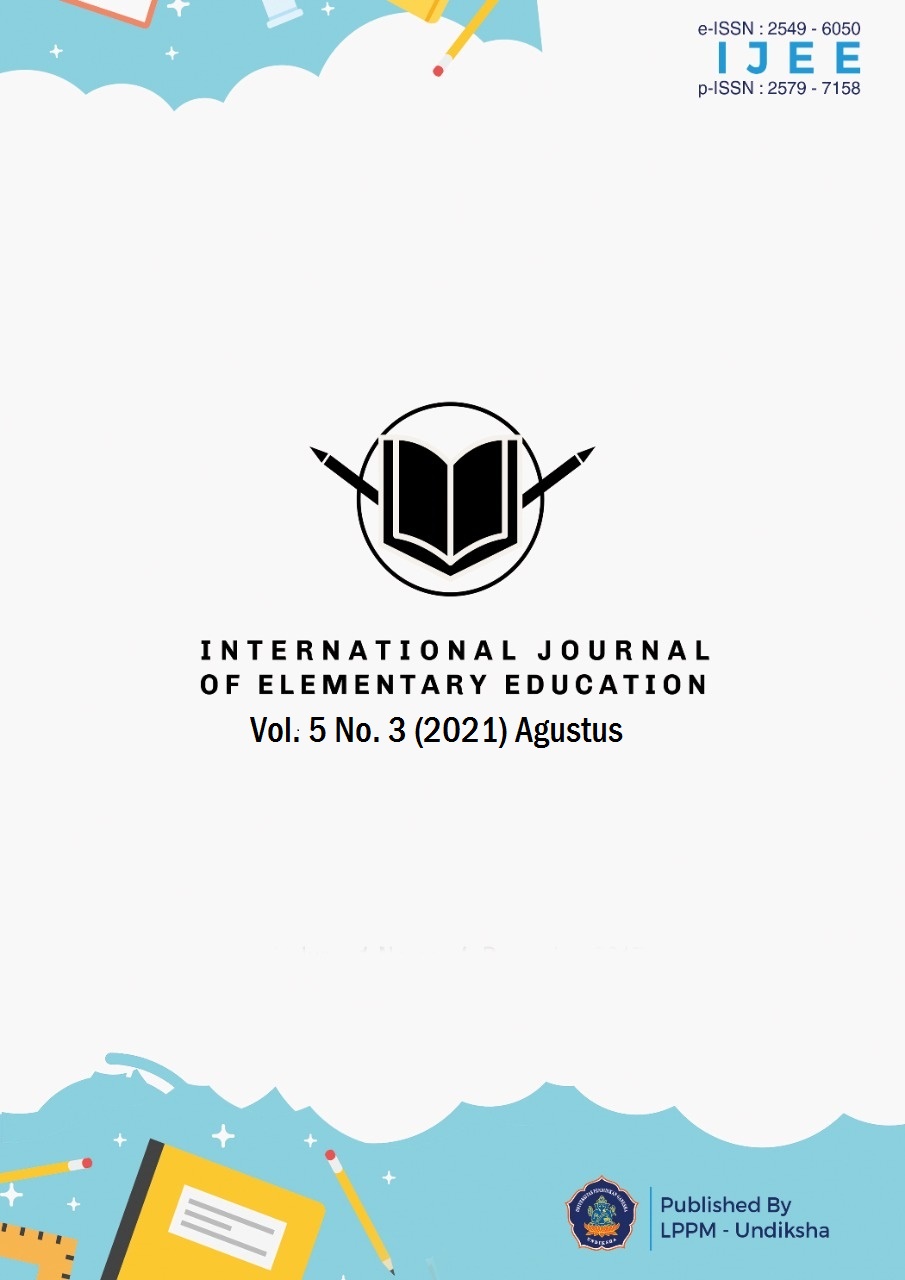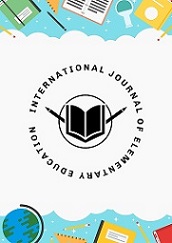Integration of HOTS-Based Questions on the Theme “The Beauty of Togetherness” through Fun Thinkers Learning Media for Grade IV Elementary School Students
DOI:
https://doi.org/10.23887/ijee.v5i3.37807Keywords:
HOTS, Learning Media, Fun ThinkersAbstract
The lack of use of learning media used for delivering material makes it difficult for students to understand the material. This study aims to develop media for fun thinkers based on HOTS questions for fourth grade elementary school students on theme 1, the beauty of togetherness. The development is carried out based on the ADDIE model procedure. The subjects in this development research are media fun thinkers based on HOTS questions for elementary school students grade IV theme 1 the beauty of togetherness while the object in this study is the validity of the media fun thinkers developed. This development research method is a qualitative and quantitative statistical analysis method. The data collection used is a questionnaire method with data collection instruments in the form of a rating scale by giving assessment instruments to 2 subject matter experts, 2 media experts, 2 practitioner responses, and 10 students as responses. The data obtained was calculated using the mean formula to determine the average media validity score. The average validity score of media fun thinkers based on HOTS questions in terms of material/assessment experts is 4.79 with very valid criteria, in terms of media experts it is 4.43 with very valid criteria, in terms of practitioner responses it is 4.63 with very valid criteria, and in terms of response students of 4.95 with very valid criteria. Based on the analysis conducted, the media for fun thinkers based on HOTS questions for elementary school students in grade IV, theme 1, the beauty of togetherness developed is valid and suitable for use in the learning process.
References
Agung, A. A. G. (2014). Metologi Penelitian Pendidikan. Aditya Media Publishing.
Agustiana, I. G. A. T., Tika, I. N., & Wibawa, I. M. C. (2020). Pelatihan Penggunaan Media Thinkers Fun pada Pembelajaran IPA SD untuk Meningkatkan Kemampuan Berpikir Kreatif. Proceeding Senadimas Undiksha.
Agustihana, S., & Suparno. (2018). Effectiveness of Physics Mobile Learning Media to Improve Higher Order Thinking Skills of Students in Thermodynamics. Journal of Physics: Conference Series, 1097(1). https://doi.org/10.1088/1742-6596/1097/1/012031.
Andrajati, N. H., Anis, M. B., & Mahmudi, A. (2020). Development of Online Thematic Teaching Materials Based on Higher Order Thinking Skills (HOTS) Subtheme Wealth of Energy Sources in Indonesia. IJIS Edu : Indonesian Journal of Integrated Science Education, 2(2), 152. https://doi.org/10.29300/ijisedu.v2i2.3427.
Arikunto, S. (2014). Metode Penelitian Kuantitatif, Kualitatif, dan Kombinasi (Mixed Methods). Alfabeta.
Astra, I. M., Raihanati, R., & Mujayanah, N. (2020). Development of Electronic Module Using Creative Problem-Solving Model Equipped with Hots Problems on the Kinetic Theory of Gases Material. Jurnal Penelitian & Pengembangan Pendidikan Fisika, 6(2), 181–194. https://doi.org/10.21009/1.06205.
Bialik, M., Bogan, M., Fadel, C., & Horvathova, M. (2015). Character Education for the 21st Century: What Should Students Learn? Center for Curriculum Redesign.
Budiman, A., & Jailani. (2014). Pengembangan Instrumen Asesmen Higher Order Thinking Skill (HOTS) pada Mata Pelajaran Matematika SMP Kelas VIII Semester 1. Jurnal Riset Pendidikan Matematika, 1(2), 139–150. https://doi.org/10.21831/jrpm.v1i2.2671.
Chong, E. J. M., Lim, J. S. W., Liu, Y., Lau, Y. Y. L., & Wu, V. X. (2016). Improvement of Learning Domains of Nursing Students with the Use of Authentic Assessment Pedagogy in Clinical Practice. Nurse Education in Practice, 20, 125–130. https://doi.org/10.1016/j.nepr.2016.08.002.
Citrawathi, D. M., Adnyana, P. B., & Santiasa, M. P. A. (2016). Analisis Kebutuhan untuk Pengembangan Modul Inkuiri Berbasis Pertanyaan (MIBP) di SMP. JPI (Jurnal Pendidikan Indonesia), 5(1), 1–11. https://doi.org/10.23887/jpi-undiksha.v5i1.8289.
Duriawati, A. D., Wasliman, I., Mulyanto, A., & Barlian, U. C. (2020). Implementation of Literation Based Learning Information Technology (Study at MTs Alkasyaf, Mts Nurul Huda, and MTs El-Bas Ciamis). International Journal of Nusantara Islam, 8(2), 240–253. https://doi.org/10.15575/ijni.v8i2.11338.
Fanny, A. M., & Suardiman, S. P. (2013). Pengembangan Multimedia Interaktif untuk Mata Pelajaran Ilmu Pengetahuan Sosial (IPS) Sekolah Dasar Kelas V. Jurnal Prima Edukasia, 1(1), 1. https://doi.org/10.21831/jpe.v1i1.2311.
Hajiyakhchali, A. (2013). The Effects of Creative Problem Solving Process Training on Academic Well-being of Shahid Chamran University Students. Procedia-Social and Behavioral Sciences, 84, 549–552. https://doi.org/10.1016/j.sbspro.2013.06.602.
Ilsa, A., F, F., & Harun, M. (2020). Pengembangan Video Pembelajaran dengan Menggunakan Aplikasi Powerdirector 18 di Sekolah Dasar. Jurnal Basicedu, 5(1), 288–300. https://doi.org/10.31004/basicedu.v5i1.643.
Jummita, J., Agustiana, I. G. A. T., & Dibia, I. K. (2021). Media Fun Thinkers Berbasis Soal Calistung pada Tema 7 Benda, Hewan, dan Tanaman di Sekitarku untuk Siswa SD Kelas 1. Jurnal Pedagogi Dan Pembelajaran, 4(2). https://doi.org/10.23887/jp2.v4i2.37258.
Juwantara, R. A. (2019). Analisis Teori Perkembangan Kognitif Piaget pada Tahap Anak Usia Operasional Konkret 7-12 Tahun dalam Pembelajaran Matematika. Jurnal Ilmiah Pendidikan Guru Madrasah Ibtidaiyah, 9(1), 27–34. https://doi.org/10.18592/aladzkapgmi.v9i1.3011.
Kurniati, D., Harimukti, R., & Jamil, N. A. (2016). Kemampuan Berpikir Tingkat Tinggi Siswa SMP di Kabupaten Jember dalam Menyelesaikan Soal Berstandar PISA. Jurnal Penelitian Dan Evaluasi Pendidikan, 20(2), 142–155. https://doi.org/10.21831/pep.v20i2.8058.
Kurniawati, E. S. (2017). Pengaruh Media Fun Thinkers terhadap Penguasaan Kosakata Bahasa Inggris Anak Tunarungu Kelas VII SMPLB-B di SLB Wiyata Dharma 1 Sleman. Jurnal Widia Ortodidaktika, 6(7), 654–664.
Lawrence, G., Ahmed, F., Cole, C., & Johnston, K. P. (2020). Not More Technology but More Effective Technology: Examining the State of Technology Integration in EAP Programmes. RELC Journal, 51(1), 101–116. https://doi.org/10.1177/0033688220907199.
Muyaroah, S., & Fajartia, M. (2017). Pengembangan Media Pembelajaran Berbasis Android dengan Menggunakan Aplikasi Adobe Flash CS 6 pada Mata Pelajaran Biologi. Innovative Journal of Curriculum and Educational Techology, 6(2), 22–26. https://doi.org/https://doi.org/10.15294/ijcet.v6i2.19336.
Nofrion, N., & Wijayanto, B. (2018). Learning Activities in Higher Order Thinking Skill (HOTS) Oriented Learning Context. Geosfera Indonesia, 3(2), 122–130. https://doi.org/10.19184/geosi.v3i2.8126.
Prananda, G. (2020). Pengembngan Media Video Pembelajaran Tema 6 Subtema 2 untuk Siswa Kelas SD Negeri 17 Pasar Masurai 1. Jurnal Dharma PGSD, 1(1), 38–45.
Primasari, I. F. N. D., & Supena, A. (2020). Peran Orang Tua Anak Berkebutuhan Khusus (Autis) Sekolah Dasar selama Masa Covid-19. JS (Jurnal Sekolah), 5(1), 133–142. https://doi.org/https://doi.org/10.24114/js.v5i1.23309.
Rehusisma, L. A., Indriwati, S. E., & Suarsini, E. (2017). Pengembangan Media Pembelajaran Booklet dan Video Sebagai Penguatan Karakter Hidup Bersih dan Sehat. Jurnal Pendidikan: Teori, Penelitian, dan Pengembangan, 2(9), 1238–1243.
Riani, R. P., Huda, K., & Fajriyah, K. (2019). Pengembangan Media Pembelajaran Tematik “Fun Thinkers Book” Tema Berbagai Pekerjaan. Jurnal Sinektik, 2(2), 173–184. https://doi.org/10.33061/js.v2i2.3330.
Saroh, I. (2016). Pengembangan Media Flash Card Fun Thinkers Tematik sebagai Pendukung Pembelajaran Saintifik pada Siswa Kelas II SD N Karangtempel. Universitas PGRI Semarang.
Selman, Y. F., & Jaedun, A. (2020). Evaluation of The Implementation of 4C Skills in Indonesian Subject at Senior High Schools. Jurnal Pendidikan Indonesia, 9(2), 244–257. https://doi.org/10.23887/jpi-undiksha.v9i2.23459.
Seruni, R., Munawaoh, S., Kurniadewi, F., & Nurjayadi, M. (2019). Pengembangan Modul Elektronik (E-Module) Biokimia pada Materi Metabolisme Lipid Menggunakan Flip Pdf Professional. Jurnal Tadris Kimiya, 4(1), 48–56. https://doi.org/10.15575/jtk.v4i1.4672.
Setiawan, D. A., Wahjoedi, W., & Towaf, S. M. (2018). Multimedia Interaktif Buku Digital 3D. Jurnal Pendidikan, 3(9), 1133–1141. https://doi.org/10.17977/jptpp.v3i9.11532.
Sugiyono. (2018). Metode Peneiltian Kuantitatif, Kualitatif, dan R&D. In Alfabeta Bandung.
Suryatin, S., & Sugiman, S. (2019). Comic Book for Improving the Elementary School Students’ Mathematical Problem Solving Skills and Self-Confidence. Jurnal Prima Edukasia, 7(1), 58–72. https://doi.org/10.21831/jpe.v7i1.10747.
Tegeh, I. M., & Jampel, I. n. (2017). Metode Penelitian Pengembangan. Undiksha Singaraja.
Tegeh, M., Pudjawan, K., & Jampel, N. (2015). Model Penelitian Pengembangan. Graha Ilmu.
Tirri, K., Cho, S., Ahn, D., & Campbell, J. R. (2017). Education for Creativity and Talent Development in the 21st Century. Education Research International, 2017, 1–2. https://doi.org/10.1155/2017/5417087.
Trilling, B., & C., F. (2009). 21st Century Skills: Learning for Life in Our Times. Jossey-Bass.
Vince, M., & Muhtadi, A. (2019). Pengembangan Buku Digital Interaktif Matematika pada Materi Geometri. Jurnal Inovasi Teknologi Pendidikan, 6(2), 196–207. https://doi.org/10.21831/jitp.v6i2.26809.
Widihastuti, & Suyata. (2014). Model AFL untuk Meningkatkan Pemahaman dan Higher Order Thinking Skills Mahasiswa Vokasi Bidang Busana. Jurnal Penelitian dan Evaluasi Pendidikan, 18(2), 275–289.
Winangun, I. M. A. (2020). Media Berbasis Budaya Lokal dalam Pembelajaran IPA SD. Edukasi: Jurnal Pendidikan Dasar, 1(1), 65–72.
Wisada, P. D., Sudarma, I. K., & Yuda S, A. I. W. I. (2019). Pengembangan Media Video Pembelajaran Berorientasi Pendidikan Karakter. Journal of Education Technology, 3(3), 140. https://doi.org/10.23887/jet.v3i3.21735.
Downloads
Published
How to Cite
Issue
Section
License
Copyright (c) 2021 International Journal of Elementary Education

This work is licensed under a Creative Commons Attribution-ShareAlike 4.0 International License.
Authors who publish with the International Journal of Elementary Education agree to the following terms:
- Authors retain copyright and grant the journal the right of first publication with the work simultaneously licensed under a Creative Commons Attribution License (CC BY-SA 4.0) that allows others to share the work with an acknowledgment of the work's authorship and initial publication in this journal.
- Authors are able to enter into separate, additional contractual arrangements for the non-exclusive distribution of the journal's published version of the work (e.g., post it to an institutional repository or publish it in a book), with an acknowledgment of its initial publication in this journal.
- Authors are permitted and encouraged to post their work online (e.g., in institutional repositories or on their website) prior to and during the submission process, as it can lead to productive exchanges, as well as earlier and greater citation of published work. (See The Effect of Open Access)










